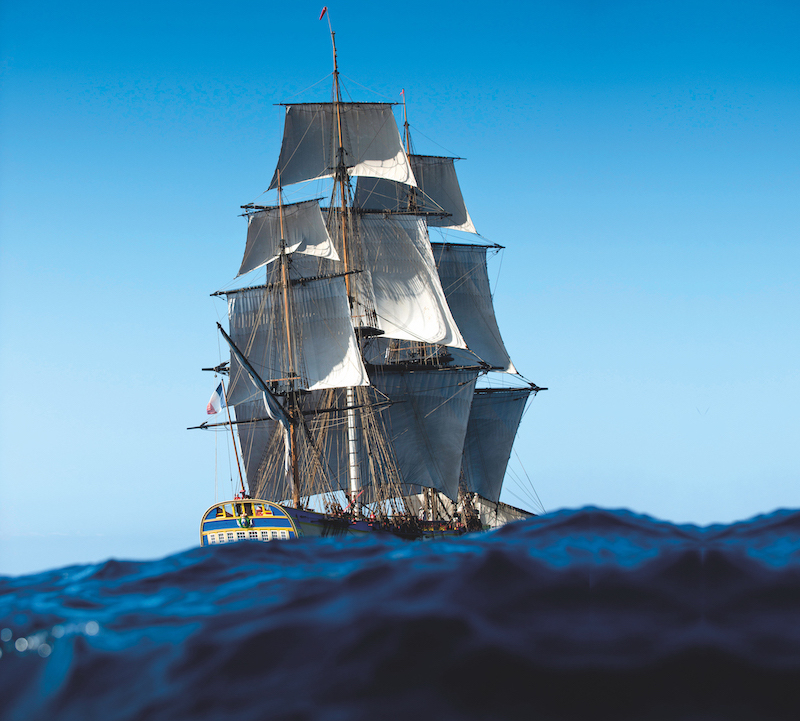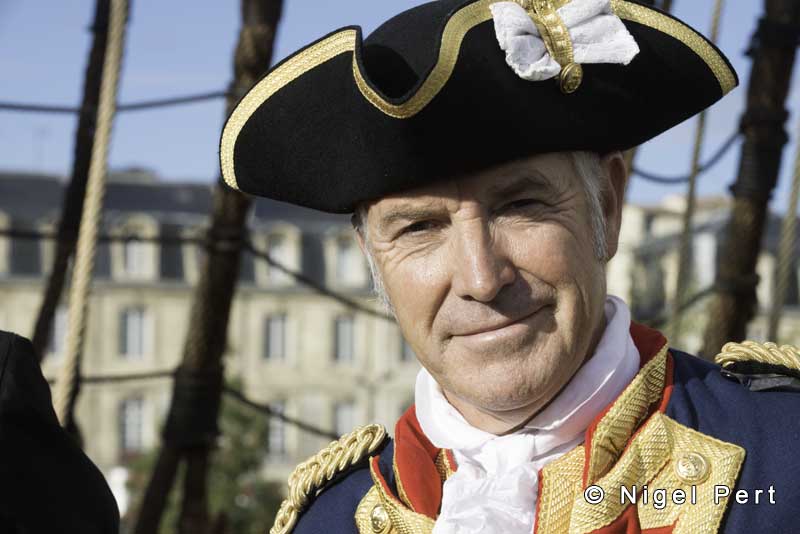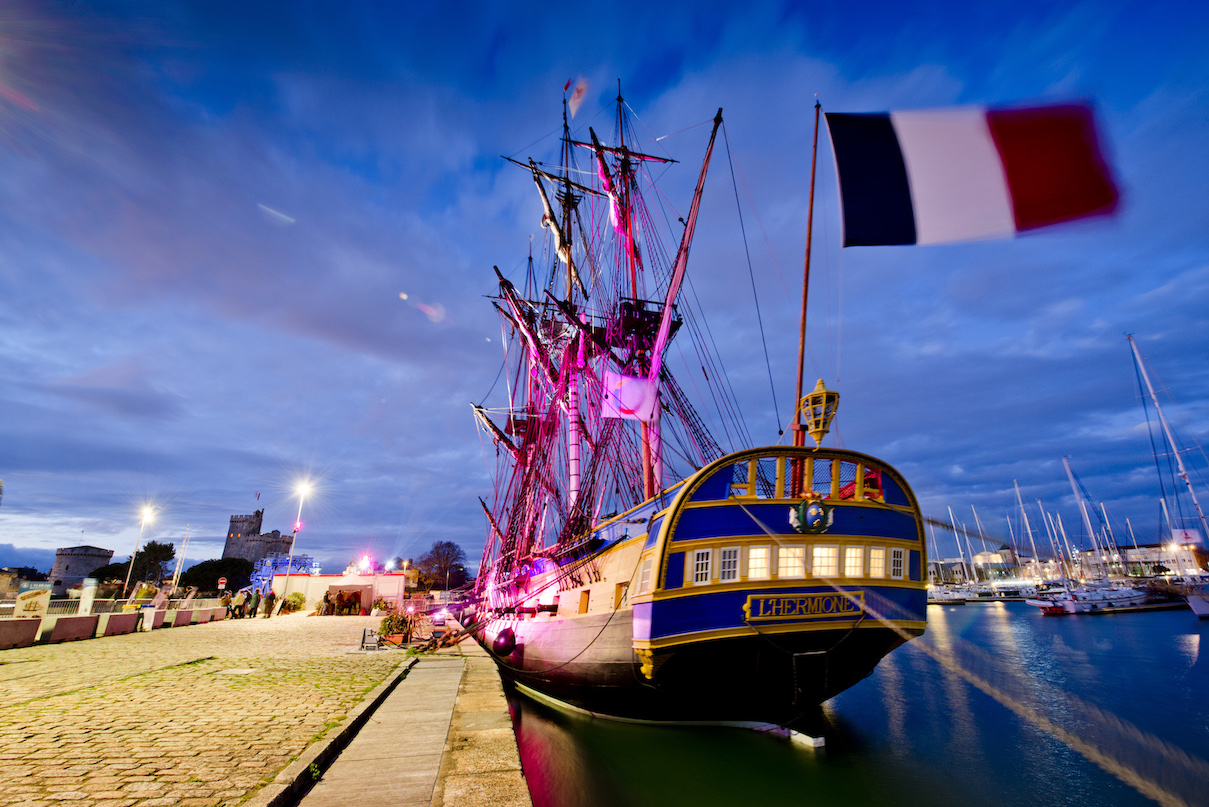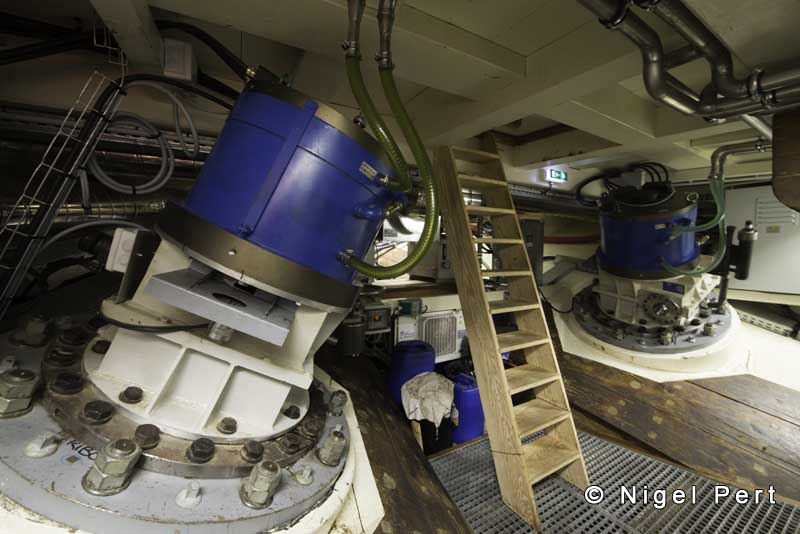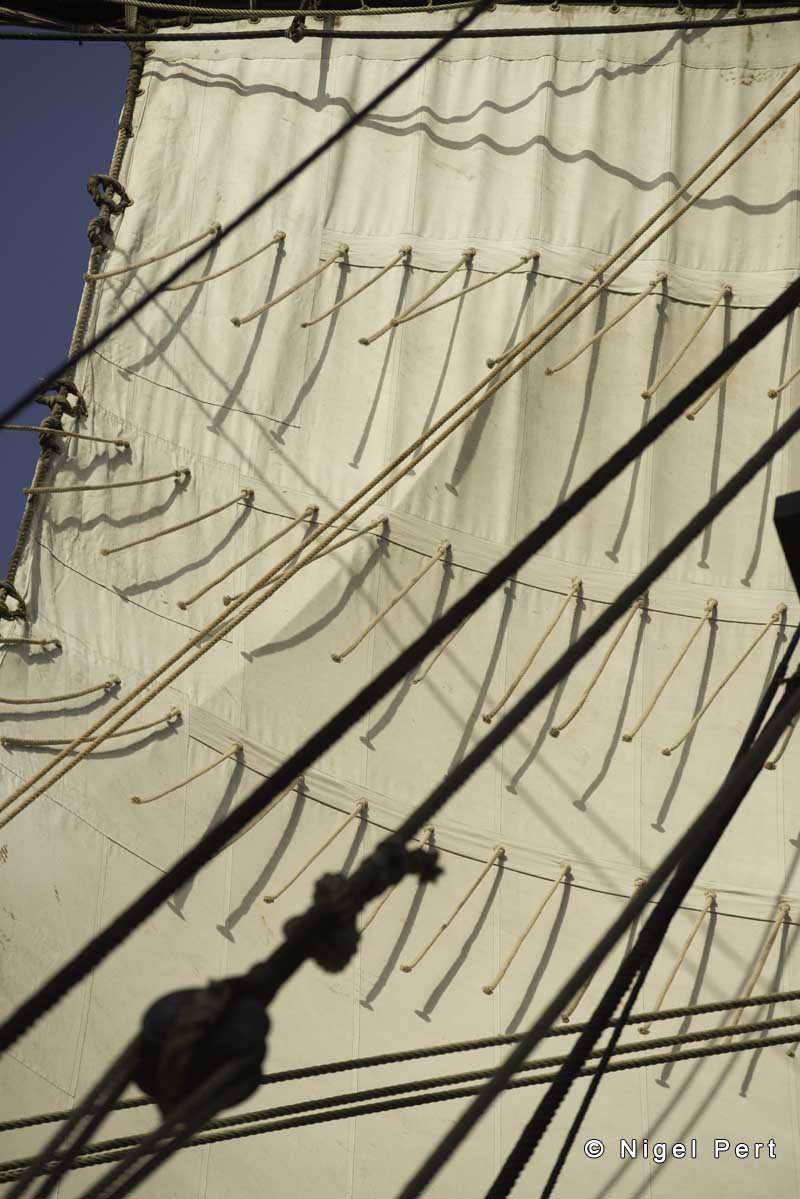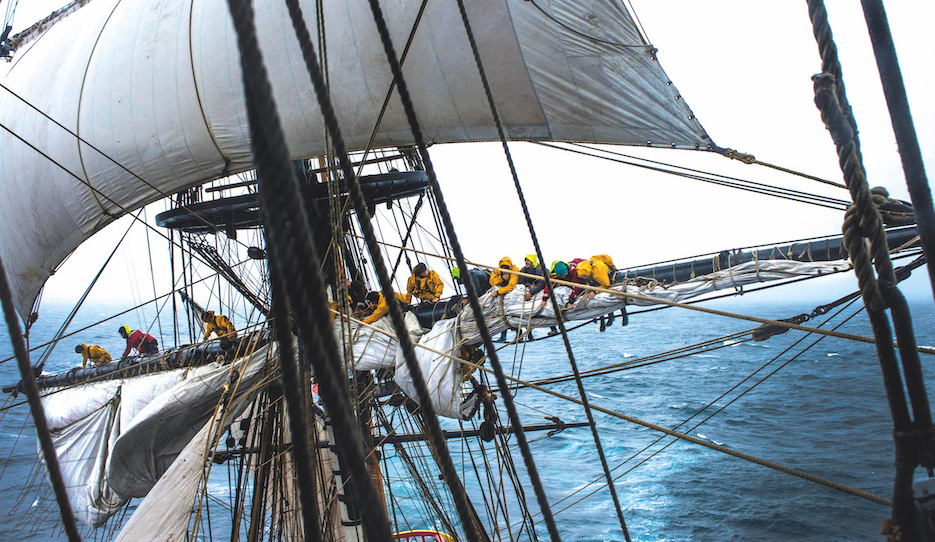Nigel Pert talks to Dan Houston about the replica sailing Frigate L’Hermione, and shares his amazing collection of photos of the ship.
The ship was launched in 2014 after a 17 year build programme in Rochefort, France. Copied from a 1779 ship of the same name, and to the same lines, she faithfully recreates history and has proved herself superbly seaworthy, and manouevrable. She voyaged to America in 2015 to re-enact the voyage of the French noble Lafayette in forging an alliance between France and revolutionary America in the war of independance. Photographer Nigel Pert has been covering (and crewing) L’Hermione since her keel was laid in 1997 and relates his experiences while sharing his amazing collection of photos with Classic Sailor visitors.
Classic Sailor covered L’Hermione in 2016 when we interviewed the ship’s captain on his experience of sailing the ship and learning about her capabilities. The following is our report at the time. Story by Sandrine Pierrefeu (Translation Nigel Pert) Photography NIGEL PERT
Last September L’Hermione left the dry dock in Rochefort, France where her ancestor had been built in 1779. All were holding their breath as the replica of one of the best ships of the 18th century, built over 17 years, slipped her lines and set out for the first few weeks of history recreated
L’Hermione’s First Voyage
Twenty or so topmen are sitting between the silent cannons on the carmine red gundeck of L’Hermione watching the cult film: Master and Commander. “Full in the topsides, narrow down below. A hull with a fine entry and a long outflow. That’s why she is so rapid,” observes the amazed Captain Jack Aubrey (played by Russell Crowe) as he scrutinises the model of an imaginary French frigate – L’Archeron. Yann Cariou, the Captain of the replica of L’Hermione, squints as he hears this key line from the film. For the last three years this deep-sea sailor, specialised in traditional Tall Ships, has immersed himself in the search for every last detail of measurements, plans, accounts of voyages and more, concerning these ships that barely anyone today knows how to build, let alone sail.
Eighteenth-century reports of the contemporary sea trials of L’Hermione, La Concorde, La Fée and La Courageuse – four almost identical sisterships – pronounced them near perfect: “Their motion at sea is gentle and they are excellent when hove to… They pull slightly to windward, which is necessary to hold a true route; they aren’t sloppy and go about with remarkable ease. They have the advantage over all other frigates, especially with the wind three-quarters astern.”
Yann resumes: “At the time, rather like in racing yachts today, engineers were constantly experimenting with new hull forms or sail plans to improve performance.
“The wealth of the kingdom depended largely on the colonies and consequently achieving naval supremacy was of vital strategic and economic importance. Our frigates were the envy of the English. When they captured La Concorde they recorded the measurements in minutest detail. It was these British plans, conserved at Greenwich Maritime Museum that enabled the building of the replica of L’Hermione to be done faithfully in authentic detail. On the other hand there was scant information available to help with installing the 240 elements of running rigging and 12km of standing rigging, nor any clue of how to make it work afterwards.”
So, for Jens the rigger/bosun, Aurélien the blacksmith, Stéphane and Dominic, watch leaders and the 150 volunteer sailors who had worked in the yard and thus learned the basics of ropework, these first weeks at sea were to be an mystery-adventure. A voyage through time to a rendezvous with the masters of the 18th century.
School of the Ancient Masters
The frigate left Rochefort, and the dry dock where the original had been built, on 7 September 2014. The 18 crew members and 54 volunteer sailors, dressed in period costume, cried out their “hurrahs” to the crowd of thousands who came to salute them from the banks of the Charente. This progeny of the region, which has been partly financed from the public purse, slipped down the river 235 years after the L’Hermione of the history books.
After a period spent at anchor to re-hoist the topmasts, lowered for the passage under a bridge, L’Hermione set sail for the first time in earnest on
9 September. The concentrated topmen clambered the heights to unfurl the canvas. The topsails were braced and the foresails backed. One thousand tons of frigate heeled. In a matter of seconds the hull accelerated – a dizzying experience. Already there were five knots on the log, yet the anemometer registered only 12 to 14 knots of wind. “Extraordinary, I have never seen that, even on schooners that are very fine,” the Captain murmured. The frigate slid through the water without a bow wave or a wake. Cariou then set the vessel up for a reach – her supposed best angle of sailing.
The Malfeasance of modern Mechanics
As the crew got their first taste of sail, the two 400hp electric motors are also tested. These Italian prototype engines mounted over “Pod” propellers, could not be run before leaving the dock, for technical reasons best known to the mechanics. So their trials were to be carried out at sea. One of the pair heated excessively then broke down completely. This setback meant it became essential to put into the closest port, as best we could and find ways to alleviate the fault in this major “non-historical” element of the project. How ironic!
After several days at the quay in the commercial port of La Pallice La Rochelle, an earlier version of the prototype motors was re-installed. The crew had to hide their impatience: “You never finish preparing a sailing vessel of these dimensions,” was the philosophical response of Jens Langert, boatswain, and ex-rigger and crew leader of the Swedish Götheborg, who oversaw the installation of L’Hermione’s rig.
It is a traditional rig of wooden masts, with running and standing rigging of manilla and hemp, without a shackle or winch in sight and all smelling of Norwegian tar. It’s linked with splices, leather reinforcements, turk’s head knots and whippings. The new ropes are supple.
The crew caulks the deck, tightens the shrouds and fine-tunes the rig. And each watch does its part towards shifting the ballast. More is needed up forward to get her to sit on her lines. “The engineers of the 18th century recommended a difference of between 0.45 and 0.52m of draught from forward to aft. We have 0.63. With our current disposition of charge and despite our calculations; it’s too much,” the Captain explained.
Youth and purpose
Charlène Gicquel, first mate aboard, organises several fire drills, man overboard exercises and ship evacuation practices. “Safety is a major consideration on board,” she emphasises. Three-quarters of the crew have no experience of the sea. Although most are young – somewhere between 25 and 30 – and fit, these youngsters, a third of whom are women, need to be trained to confront emergency situations.
“The foremost criterion applied in selecting the volunteer crew members was their enthusiasm,” Yann explained. He chose and trained 150 who often stayed to work on the build before the frigate set sail. This was key to their chances of embarking for part of next year’s four-month voyage to north America.
“We obviously had to select our crew for their availability, physical condition and youth,” said Yann. “The boat is very physical and we are operating with far fewer crew than at the time, when there would have been around 200 sailors aboard.”
The proof of this reasoning is borne out as these sailors are already run-in. Alizée, who had never sailed before last summer is already perfectly at ease doing acrobatics in the heights of the rig. Adèle, a political sciences student, is helping newcomers furl the spritsail, the squaresail flown from the bowsprit. “You have already sailed?” “Yes, the other day, when we left Rochefort.” “And before that?” “Well, not really.”
The topwomen of L’Hermione stand side by side with their new companions, thrown together by chance. They climb, caulk a seam and they heave at the block and tackle – just like the lads with whom they share watches, daily tasks, dormitories and showers. The first question of these trials is already answered: this fine mix of backgrounds, ages and sexes creates an atmosphere that is keen and united, attentive and responsible. A true team – and happy!
Making the linen sing
There is a northerly breeze. Ideal to push our bows towards Ushant. The time has come to make our linen sing! The frigate is running at three knots to the west, skimming across the water with only eight knots of breeze. The roll is gentle. The oak planks are working for the first time. They groan and slide, block and support each other. At the same time, as the hull settles in, a few faces twist and stiffen as they discover the discomfort of the high seas. The sun sets on the first day at sea – for the vessel and its men.
The next day, in the Bay of Biscay, the sails are set one by one. The frigate leans to her 2,000m² of linen canvas. She is slightly heeled as she cuts through the sea making virtually no wash. Two whirlpools start at either side of the bow, as if she is turning the elements to her advantage. She creates a vacuum, a passage, in front of her, with power and connivance. “Above the waterline she is round, but below she is a clipper,” Yann remarks.
The sails bloom, then are furled. Linen cracks like gunfire; sails assembled from machine sewn strips that are finished – hand sewn around the edges, as before. They are like living entities, this foresail, this spritsail, these topsails and royals. To reach them you have to leave the shrouds and venture out on the yards.
The landlubbers marinise. They discover the art of getting about on a moving deck. They get used to sleeping in a hammock, not to tighten it too much so as you fall, nor to tie it too loose and get a crick in the neck. We sit out a passing front at Ushant and then it’s up anchor for another start – this time south, with a breeze of 25 knots from the northwest.
Passage to north America
And so, our frigate flies. She accelerates, eight, nine, then ten knots before passing up a gear. We brace and trim, we take up to “Ho! Hisse!” Little by little the helmsmen get used to the movement of the tiller, a huge bulk of timber 23ft (7m) long that’s swung by cordage turned around the great double wheel. They are two on the wheel, steering by degrees. All our topsails are set as well as the lower courses, fore and main sails, the fore topmast staysail and main staysail. The swell starts to move us on and the log shows 11, 12 knots; 12.7 knots during that night that follows. On board a state of bliss hangs in the air. After all the hopes and effort – to achieve such a gallop…
According to the contemporary records, L’Hermione gave time to all the other frigates, that is to say she had the advantage even over those in her own series.
“We have the best ship in the world in our hands,” Captain Cariou states ecstaticly, and the sentiment is echoed through the crew. Even close-hauled, L’Hermione performs well. “I’ve lost my bet. I promised everyone Champagne if she would sail at 75° to the wind. We are making way at 68°! Those old-timers were magicians.”
The frigate follows the wind along a front until she is on a broad reach, south-southeast headed towards the Gironde and her first official visit to Bordeaux.
Later she could be seen practising manoeuvres off the English coast. The crew are masters their ship. Through to November L’Hermione clocked up 2,200 miles, often in rough conditions. For the Captain and the Association Hermione La Fayette the sea trials are ‘mission accomplished’. And from March 2015, after winter maintenance in her home port of Rochefort, she will undertake a voyage of 10,000 miles over four months.
End note: On 18 April 2015 L’Hermione sailed for North America, where she engaged in commemorative celebrations. She enjoyed a great welcome reflecting the the importance her original played in the independence of the United States of America. On 14 July, she participated in a grand Independence Day parade in New York. See her arrival below:
Fabrication of a frigate
The hull: is built from 2,000 oak trees
The masts: are made in strips, using epoxy resin adhesives
The original sails: were of hemp, the replica sails are linen, which is less fragile, but demanding, as they need to be unfurled and dried when used. Three sailmakers were involved: Incidence, at La Rochelle, the Noirmoutier based sailmaker Burgaud and Anne Renault of Fouras hand finished every sail.
The rigging: consists of 28km of rope: 12 for the standing rigging and 16 for the running rigging. It consists of manila or hemp, both natural fibres. Halyards and topping lift are all in synthetic fibre for added safety. This rare type of rig is found for example on the Göteborg and the Endeavour.
Metallic pieces: L’Hermione carries 1,200 metallic pieces, including 800 pulleys; 26, 12 lb cannon
Maximum speed under sail: 14 knots
Crew: 78, including 54 volunteers.


